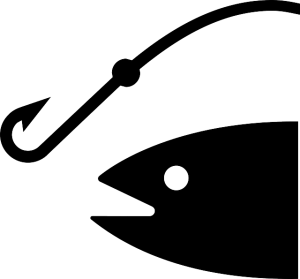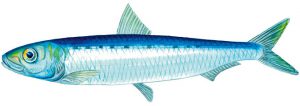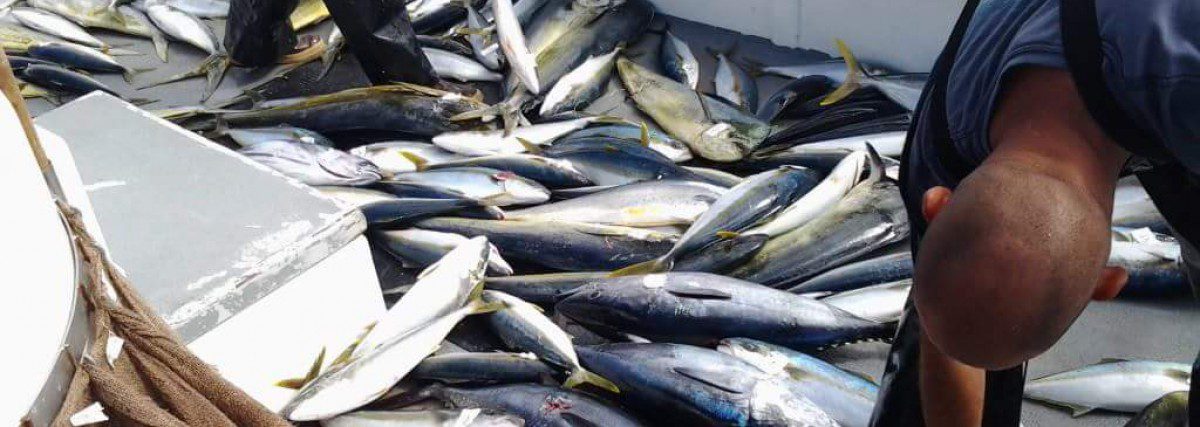Saltwater Fishing Live Bait – Using the Belly Hook
Welcome aboard fishermen! This is for those of you who fish live bait. After reading this article, you’re going to start using the belly hook technique.
I promise. I’m going to convince you that when saltwater fishing live bait should almost always be belly hooked.
What is Fly Lining?
There’s probably many different terms for it. When we take to the sea in search of game fish out of San Diego, we use a technique that we call fly lining. What do we mean by this?
Fly lining requires only a hook tied to the end of your line. It makes use of live bait. By properly hooking a live sardine or mackerel, we are able to let them free swim. Releasing the bail of our reel allows the bait fish to swim out until larger game fish attack.
To learn more about line selection, read my post Choosing Fishing Line.
To learn more about hook selection, read Fish Hook Sizes.
Why Is Hook Placement Important When Fly Lining?

For a long time hook placement didn’t seem to matter to me. I usually would nose hook a sardine. Sometimes I’d switch to belly hooking, especially if I wasn’t getting bit. Time went by, and I started paying more attention to how others were fishing. Then came captain Greg.
Greg Gawitt is one of the premier captains that runs out of San Diego. One of the reasons people love to fish with Greg is because he teaches them. On one of my trips with Greg aboard the Pride, he gave his seminar on belly hooking. I’ve fished this way ever since.
What did Captain Greg have to Say about Saltwater Fishing Live Bait?
Captain Greg taught us the best place to hook a sardine when saltwater fishing live bait. He gave 3 main reasons why belly hooking a fly lined bait will hook more fish.

The Belly Hook goes between the pelvic and anal fin. Both located on the bottom of the fish, as seen in the image. The hook goes straight through the belly, and out the other side.
3 Reasons why Belly Hooking a Fly Lined Bait will Hook more Fish!
One – Belly Hooking gives you Control over the Bait
When a nose hooked bait is cast into the water, it is going to tend to swim in the direction it lands. This means you have maybe a 50% chance that the sardine will swim the way you want it to. Away from the boat.
With belly hooking, the hook acts as a swivel. This allows the angler to turn the bait away from the boat (and himself). We do this by pulling in a little line, which swivels the bait’s head out.
Two – A Belly Hooked Bait Swims more Naturally
The bait fish will have to swim with all that line beside it if it is nose hooked. This doesn’t look natural. It also defeats the argument that belly hooking injures the bait. A nose hooked bait will beat itself against the line as it swims out.
A belly hooked bait will swim naturally. The hook will be tucked and much more concealed. The line will come off under, and behind it. This leaves the whole body of the bait open to free swim.
Three – Get more Life Out of a Belly Hooked Bait
Once a nose hooked bait runs out of gas and stops swimming, that’s the end of it. You have a small chance of getting a bite as you reel it back in. Not so with the belly hook!
When our belly hooked bait poops out, we have a little trick. Reel it in a few turns. As discussed, this will swivel the fish and bring it in backwards. It will also force water backwards through the bait’s gills. This drowns a fish, since gills don’t work that way. Just a few turns will freak that bait out and give it new life!
What about Hooking an Anchovy?
 The anchovy is a much smaller fish than the sardine. It has a soft belly, and it’s easy for the hook to rip or shake out.
The anchovy is a much smaller fish than the sardine. It has a soft belly, and it’s easy for the hook to rip or shake out.
I recommend hooking anchovies straight down through the nose and mouth. Make sure you go through the bottom jaw.
An alternate method is to hook the chovy through its collar bone (just on one side).
What are the Drawbacks to Belly Hooking Sardines?
There are a few drawbacks to belly hooking when saltwater fishing live bait, as well as situations when belly hooking is best avoided.
Drawbacks
- You will lose the opportunity to get a strike as you retrieve your bait. The but hooked bait will drag and tear off your hook as you retreive it.
- You can miss a top water only bite. Belly hooking tends to force a bait to swim lower in the water than a nose hooked cousin.
Times to Avoid Using the Belly Hook
- On the slide. This one’s a bit of a toss up. The slide is when the boat cuts it’s engines but is still “sliding forward”. Fish can be caught on the slide with either method of hook placement. I think the nose hook gives better presentation in this situation.
- Slow trolling. This is definitely a time to nose hook. No other method will do.
- During a top water only bite. The best thing to do in this situation is to cast a jig. Throw the iron as we say. If you aren’t comfortable casting yet, use the nose hook.
Final Verdict? – Belly Hooking is Best!
Now that you’re a believer, head on over to my equipment review page. Or maybe learn about the best sunglasses in the fishing industry.
If you are still not a believer in the belly hook (or if you’re just friendly), head on down to the comment box and tell me why! Better make it good! Thanks, Geoff@FishtFight.com


What about smaller (3-5″) greenbacks (pilchards)?
thx
Hi John. Good question and being a west coast angler. we use sardines and anchovies. So I did some digging and it appears anglers hook pilchards the same basic way. Anytime you’re fishing in a stationary or drift type position, the belly hook (tail hook same thing) gets the pilchard slightly down and away from you. Trolling, kiting, moving vessels require a nose hook. It allows them to torpedo through the water. Hook the through the nose and bottom lip to keep water from blowing through the fish while trolling. Here’s some more good literature that backs up my statements. Thanks for joining the discussion John and tight lines. Geoff.
I want to try this with bunker for striped bass. Have you?
I have not, but perhaps some east coast readers have. I wouldn’t necessarily recommend the belly hook if you’re using weight to get down to the bottom. It’s best for fly lining from a drift or stationary position. Here’s a good article about using live bunker for stripers.